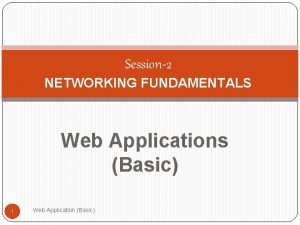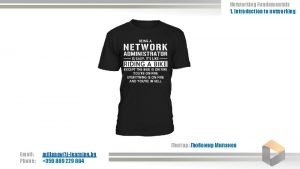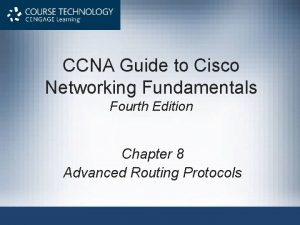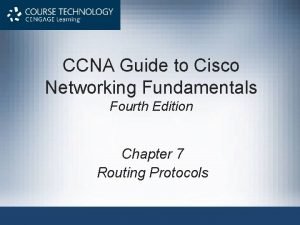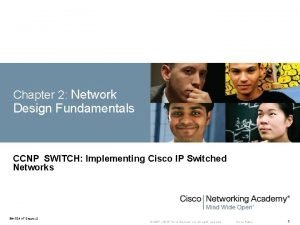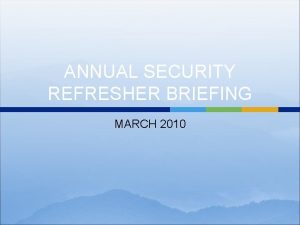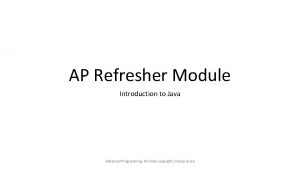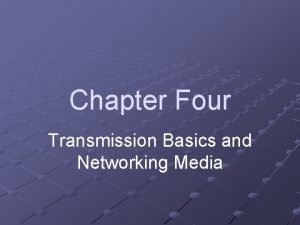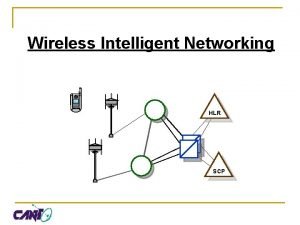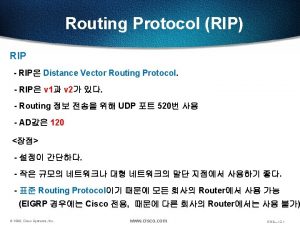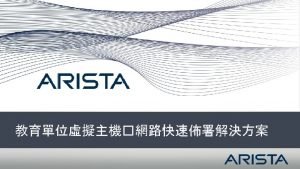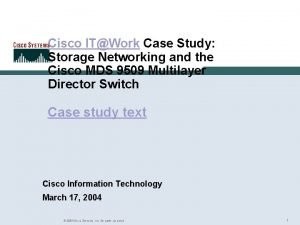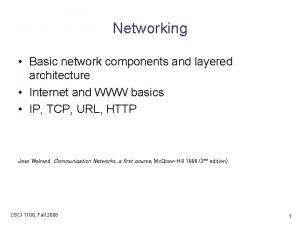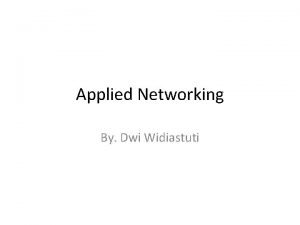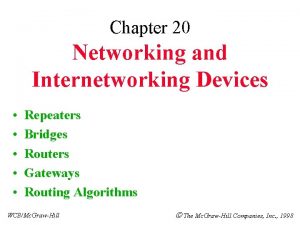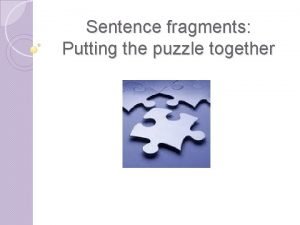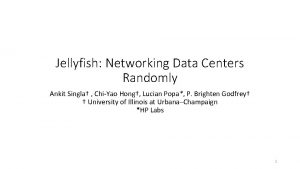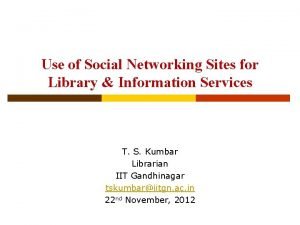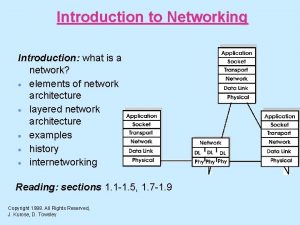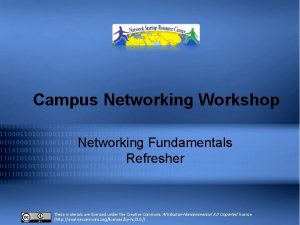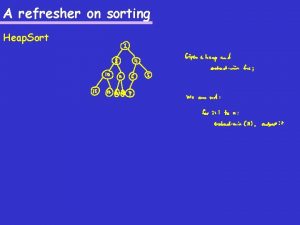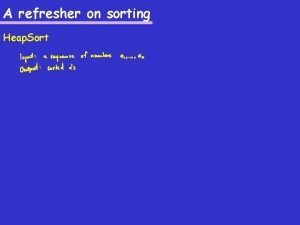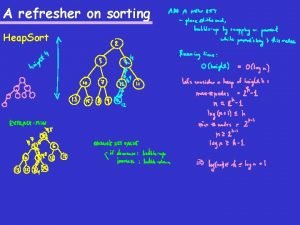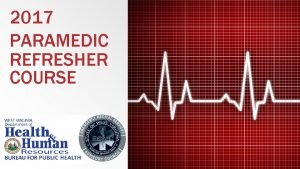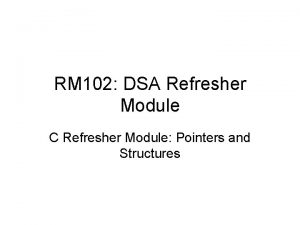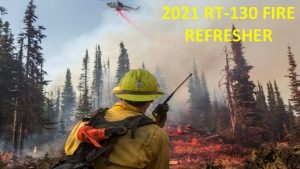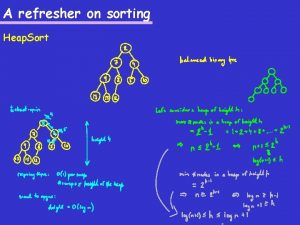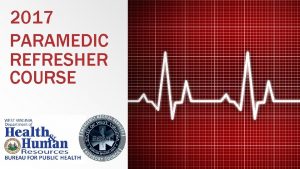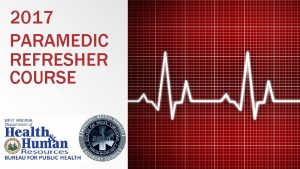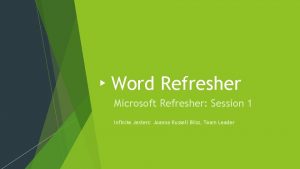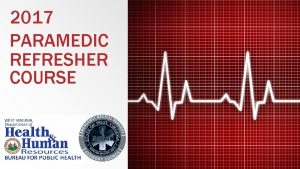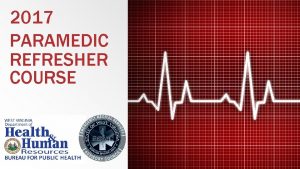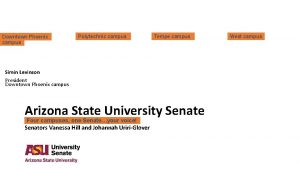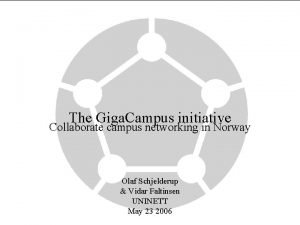Campus Networking Workshop Networking Fundamentals Refresher These materials


















































- Slides: 50

Campus Networking Workshop Networking Fundamentals Refresher These materials are licensed under the Creative Commons Attribution-Noncommercial 3. 0 Unported license (http: //creativecommons. org/licenses/by-nc/3. 0/)

Objectives • To revise the core concepts • To ensure we are using the same terminology

What is this? 7 Application 6 Presentation 5 Session 4 Transport 3 Network 2 Link 1 Physical

Layer 1: Physical Layer • Transfers a stream of bits • Defines physical characteristics • • Connectors, pinouts Cable types, voltages, modulation Fibre types, lambdas Transmission rate (bps) • No knowledge of bytes or frames 101101 Examples of Layer 1 technologies and standards?

Types of equipment • Layer 1: Hub, Repeater, Media Convertor • Works at the level of individual bits • All data sent out of all ports • Hence data may end up where it is not needed

Building networks at Layer 1 What limits do we hit? Rpt Rpt Hub Hub

Layer 2: (Data)Link Layer • Organises data into frames • May detect transmission errors (corrupt frames) • May support shared media • Addressing (unicast, multicast) – who should receive this frame • Access control, collision detection • Usually identifies the layer 3 protocol being carried

Example Layer 2: SLIP Flag That's it! Information Flag

Example Layer 2: PPP Flag Protocol Information CRC Also includes link setup and negotiation - Agree link parameters (LCP) - Authentication (PAP/CHAP) - Layer 3 settings (IPCP) Flag

Example Layer 2: Ethernet Header Preamble Dest Src MAC Proto Information CRC Gap • MAC addresses • Protocol: 2 bytes - e. g. 0800 = IPv 4, 0806 = ARP, 86 DD = IPv 6 • Preamble: carrier sense, collision detection

Types of equipment (contd) • Layer 2: Switch, Bridge • Receives whole layer 2 frames and selectively retransmits them • Learns which MAC addr is on which port • If it knows the destination MAC address, will send it out only on that port • Broadcast frames must be sent out of all ports, just like a hub • Doesn’t look any further than L 2 header

Building networks at Layer 2 • What limits do we hit? Switch

Layer 3: (Inter)Network Layer • Connects Layer 2 networks together - Forwarding data from one network to another • Universal frame format (datagram) • Unified addressing scheme - Independent of the underlying L 2 network(s) - Addresses organised so that it can scale globally (aggregation) • Identifies the layer 4 protocol being carried • Fragmentation and reassembly

Example Layer 3: IPv 4 Datagram Header Version, length, TTL flags, fragments hdr csum Proto Src IP Dest IP Information • Src, Dest: IPv 4 addresses • Protocol: 1 byte - e. g. 6 = TCP, 17 = UDP (see /etc/protocols)

Types of equipment (contd) • Layer 3: Router • Looks at the dest IP in its Forwarding Table to decide where to send next • Collection of routers managed together is called an “Autonomous System” • The forwarding table can be built by hand (static routes) or dynamically - Within an AS: IGP (e. g. OSPF, IS-IS) - Between ASes: EGP (e. g. BGP)

Traffic Domains Router Switch Hub Broadcast Domain Hub Collision Domain

Network design guidelines • No more than ~250 hosts on one subnet - Implies: subnets no larger than /24 • Campus guideline: one subnet per building - More than one may be required for large buildings

Layer 4: Transport Layer • Identifies the endpoint process - Another level of addressing (port number) • May provide reliable delivery - Streams of unlimited size Error correction and retransmission In-sequence delivery Flow control • Or might just be unreliable datagram transport

Example Layer 4: UDP Header Src Port Dst Port Len Checksum Information • Port numbers: 2 bytes - Well-known ports: e. g. 53 = DNS - Ephemeral ports: ≥ 1024, chosen dynamically by client

Layers 5 and 6 • Session Layer: long-lived sessions - Re-establish transport connection if it fails - Multiplex data across multiple transport connections • Presentation Layer: data reformatting - Character set translation • Neither exist in the TCP/IP suite: the application is responsible for these functions

Layer 7: Application layer • The actual work you want to do • Protocols specific to each application • Examples?

Encapsulation • Each layer provides services to the layer above • Each layer makes use of the layer below • Data from one layer is encapsulated in frames of the layer below

Encapsulation in action L 2 hdr L 3 hdr L 4 hdr Application data • L 4 segment contains part of stream of application protocol • L 3 datagram contains L 4 segment • L 2 frame contains L 3 datagram in its data portion

For discussion • Can you give examples of equipment which operates at layer 4? At layer 7? • At what layer does a wireless access point work? • What is a “Layer 3 switch”? • How does traceroute find out the routers which a packet traverses?

Addressing at each layer • What do the addresses look like? • How do they get allocated, to avoid conflicts? • Examples to consider: - L 2: Ethernet MAC addresses - L 3: IPv 4, IPv 6 addresses - L 4: TCP and UDP port numbers

IPv 4 addresses • 32 -bit binary number - How many unique addresses in total? • Conventionally represented as four dotted decimal octets 1000000011011111100111010011 128 . 223 . 157 . 19

Hierarchical address allocation 0. 0 IANA 255 RIR LIR End User

Prefixes 32 bits Prefix /27 27 bits Host 5 bits • A range of IP addresses is given as a prefix, e. g. 192. 0. 2. 128/27 • In this example: - How many addresses are available? - What are the lowest and highest addresses?

Prefix calculation 192 . 0 . 2 . 128 1100000000001010000000 Prefix length /27 First 27 bits are fixed Lowest address: 1100000000001010000000 192 . 0 . 2 . 128 Highest address: 1100000000001010011111 192 . 0 . 2 . 159

IPv 4 “Golden Rules” 32 bits Prefix /27 27 bits Host 5 bits 1. All hosts on the same L 2 network must share the same prefix 2. All hosts on the same subnet have different host part 3. Host part of all-zeros and all-ones are reserved

Golden Rules for 192. 0. 2. 128/27 • • Lowest 192. 0. 2. 128 = network address Highest 192. 0. 2. 159 = broadcast address Usable: 192. 0. 2. 129 to 192. 0. 2. 158 Number of usable addresses: 32 - 2 = 30

Exercises • Network 10. 10. 0/25 • How many addresses in total? • How many usable addresses? • What are the lowest and highest usable addresses? • Network 10. 20. 0/22 • How many addresses in total? • How many usable addresses? • What the lowest and highest usable addresses?

An edge case • How many usable addresses in a /30 prefix? • What is this used for? • (Note: modern routers support /31 for this purpose to reduce IP address wastage)

Netmask • Netmask is just an alternative (old) way of writing the prefix length • A '1' for a prefix bit and '0' for a host bit • Hence N x 1's followed by (32 -N) x 0's /27 = 1111111111111100000 255 . 255. 224

Subnetting • Since each L 2 network needs its own prefix, then if you route more than one network you need to divide your allocation • Ensure each prefix has enough IPs for the number of hosts on that network End User Allocation Subnets

Subnetting Example • You have been given 192. 0. 2. 128/27 • However you want to build two Layer 2 networks and route between them • The Golden Rules demand a different prefix for each network • Split this address space into two equalsized pieces - What are they?

Subnetting /27 192 . 0 . 2 . 128 1100000000001010000000 Move one bit from host part to prefix We now have two /28 prefixes 1100000000001010000000 192 . 0 . 2 . 128 Second prefix: 1100000000001010010000 192 . 0 . 2 . 144

Check correctness • Expand each new prefix into lowest and highest • Ranges should not overlap • 192. 0. 2. 128/28 • • Lowest (network) = 192. 0. 2. 128 Highest (broadcast) = 192. 0. 2. 143 • 192. 0. 2. 144/28 • • Lowest (network) = 192. 0. 2. 144 Highest (broadcast) = 192. 0. 2. 159 • How many usable addresses now?

Aggregation tree • Continue to divide prefixes as required • Can visualize this as a tree /24 /25 /26 /27 /27

Questions on IPv 4?

IPv 6 addresses • 128 -bit binary number • Conventionally represented in hexadecimal – 8 words of 16 bits, separated by colons 2001: 0468: 0 d 01: 0103: 0000: 80 df: 9 d 13 • Leading zeros can be dropped • One contiguous run of zeros can be replaced by : : 2001: 468: d 01: 103: : 80 df: 9 d 13

Hexadecimal 0000 0001 0010 0011 0100 0101 0110 0111 0 1 2 3 4 5 6 7 1000 1001 1010 1011 1100 1101 1110 1111 8 9 a b c d e f 0000 = 00000000 ffff = 11111111

IPv 6 rules • With IPv 6, every network prefix is /64 - (OK, some people use /127 for P 2 P links) • The remaining 64 bits can be assigned by hand, or picked automatically - e. g. derived from NIC MAC address • There are special prefixes - e. g. link-local addresses start fe 80: : • Total available IPv 6 space is ≈ 261 subnets • Typical end-user allocation is /48 (or /56)

IPv 6 addressing network prefix host ID /64 /48 assigned address space network ID • How many /64 networks can you build given a /48 allocation?

IPv 6 addressing • You are assigned 2001: db 8: 123: : /48 • 2001: 0 db 8: 0123: 0000: 0000 • Lowest /64 network? • 2001: db 8: 123: 0000: : /64 • written simply 2001: db 8: 123: : /64 • Highest /64 network? • 2001: db 8: 123: ffff: : /64

Ways to allocate the host part • Do it automatically from MAC address – "stateless autoconfiguration" • Not recommended for servers: if you change the NIC then the IPv 6 address changes! • Can number sequentially from 1, or use the last octet of the IPv 4 address • Or embed the whole IPv 4 address • e. g. 2607: 8400: 2880: 4: : 80 df: 9 d 13 • 80 df 9 d 13 hex = 128. 223. 157. 19 in decimal • Can write 2607: 8400: 2880: 4: : 128. 223. 157. 19

Questions on IPv 6?

Notes on IPv 6 • Broadly similar to IPv 4 • "ARP" is replaced by "NDP" • IPv 6 client configuration options • Stateless autoconf (router advertisements) • Stateless autoconf + stateless DHCPv 6 • Stateful DHCPv 6 • Interfaces typically get both a link-local address and one or more routable prefixes • "Dual stack" = v 4 and v 6 side-by-side

Debugging Tools What tools can you use to debug your network: - At layer 1? At layer 2? At layer 3? Higher layers?

Other pieces • What is MTU? What limits it? • What is ARP? - Where does it fit in the model? • What is ICMP? - Where does it fit in the model? • What is NAT? PAT? - Where do they fit in the model? • What is DNS? - Where does it fit in the model?
 Software defined networking vs traditional networking
Software defined networking vs traditional networking Basic networking fundamentals
Basic networking fundamentals Networking fundamentals
Networking fundamentals Ccna
Ccna Ccna
Ccna Campus network design fundamentals
Campus network design fundamentals Gdpr refresher training
Gdpr refresher training Saeta refresher course 2021
Saeta refresher course 2021 Refresher training example
Refresher training example Rt-130
Rt-130 V/q mismatch vs shunt
V/q mismatch vs shunt Refresher training example
Refresher training example Java oop exercises
Java oop exercises Sql refresher
Sql refresher Confined space refresher training
Confined space refresher training Annual security refresher
Annual security refresher Hazmat training alaska
Hazmat training alaska Java refresher course
Java refresher course Confined space refresher training
Confined space refresher training Chemistry molarity
Chemistry molarity Ifr refresher
Ifr refresher Information security program refresher training
Information security program refresher training Biology refresher
Biology refresher Ipv refresher course
Ipv refresher course Differentiate adopting materials and adapting materials
Differentiate adopting materials and adapting materials Cant stop the feeling go noodle
Cant stop the feeling go noodle Direct materials budget with multiple materials
Direct materials budget with multiple materials Usefull and harmfull
Usefull and harmfull Man made map
Man made map Which of these materials block light
Which of these materials block light Information centric networking
Information centric networking Transmission basics and networking media
Transmission basics and networking media Any time interrogation call flow
Any time interrogation call flow Rip meaning in networking
Rip meaning in networking Types of data stuffing
Types of data stuffing Hyper-v vmq best practice
Hyper-v vmq best practice Link load balancer gartner 2016
Link load balancer gartner 2016 Cisco storage networking
Cisco storage networking Basic networking components
Basic networking components Applied networking
Applied networking Mop in networking
Mop in networking Manfaat internet bagi sekretaris
Manfaat internet bagi sekretaris Networking and internetworking devices
Networking and internetworking devices Business data communications and networking
Business data communications and networking Networking in a sentence
Networking in a sentence Error correction in computer networks
Error correction in computer networks Jellyfish networking data centers randomly
Jellyfish networking data centers randomly International networking adalah
International networking adalah Types of social networking sites
Types of social networking sites Introduction of networking
Introduction of networking An engineering approach to computer networking
An engineering approach to computer networking

